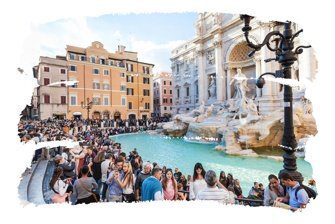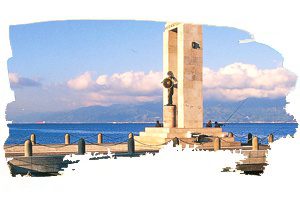What are the types of Italian wines?
The fame of Italian wines, wines and Italy: love, tradition and flavor. A good wine pleases the most discerning palates and Italy can boast of having wines for literally every taste. To give you an idea, Italy produces an average of FORTY BILLION liters of wine per year! There is wine, isn’t it ?! So let’s get to know a little better the Italian wines, regions and grapes that so enchant the world! Are you ready? After all, what are the types of Italian wines? Here at Your Travel to Italy with Ana Patricia you make the trip of your dreams!!! ALSO: see our “Accommodation in Italy – Tips for your holidays!”
Introduction
Unlike all other countries in the world, Italy uses on its labels the name of the region where the wine is produced, moreover it will always be indicating the type of wine classification. Which we will present shortly. How to bring wines from Italy in your luggagge?
Looking for a special suitcase to transport your wines?
The company responsible for these unique products is Lazenne and they deliver to any hotel/home in Europe. You can pay using your credit card, and they offer different currency choice to make your life much easier! Are you curious to learn more about it? Then click on the banner below without purchase obligation and get to know all the accessories available. You‘re gonna love the options!
1) What are the types of Italian wines? VdT
Vino da Tavola (table wine): Used to designate a “low quality” wine, without determining the region, the grapes and the production pattern. It is the only wine that has no obligation to follow an archetype for its production. Is it a bad wine? No, but it is also not a renowned wine. In the market there are wines “da Tavola” that cost about 3 Euros a bottle; if you are in Italy, it is worth trying for curiosity. Discover the Wine Routes in Tuscany here!
2) What are the types of Italian wines? IGT
Indicazione Geografica Tipica (Typical Geographical Indication): It was created in 1992 and is used by around 150 Italian wines, all from specific regions. Today it is being replaced by the IGP – Indicazione Geografica Protetta (Protected Geographical Indication), which is a classification determined by the European Union to indicate wines from certain regions. It is also not a wine of excellent quality, but it is not all bad! When is the best time to visit Italian wineries?
3) What are the types of Italian wines? DOC
Denominazione di Origine Controllata (Controlled Designation of Origin): It is the oldest of the classifications and was created in 1963. It is used in almost 300 regions and the wine authorized to use this designation must be produced with specific grapes, according to its region of origin and must, strictly, follow methods predetermined winemaking processes. See Barolo, the king of wines and its enchanted city!
4) What are the types of Italian wines? DOCG
Denominazione di Origine Controlatta e Garantita (Controlled and Guaranteed Denomination of Origin): This category includes the great and award-winning Italian wines. DOCG is only assigned to some of the DOC wines and ensures these wines are of excellent quality. It also follows specific production rules.
There are also Supertoscanos (Super Tuscans), also called “outlaw” wines. These are extraordinary wines made from Cabernet Sauvignon and Merlot. For using grapes originating outside Italy for their production, these wines were called “Vino da Távola”. However, due to its superior quality, it started to be called Supertoscano (Super Tuscan), a name that gained international fame and respect.
5) What are the types of Italian wines? RED WINE
Intense in color it is produced from the fermentation of juice, or must, extracted from black or red grapes. For its production it is necessary that there is “maceration” of the peels, which will give the wine its color and flavor. Find out here Where to buy wines in Rome, Florence and Milan?
6) What are the types of Italian wines? WHITE WINE
Golden in color and fruity flavor, it can be made from white or black grapes. Unlike red wine, white wine is served chilled and harmonizes very well with light dishes such as fish, seafood and salads.
7) What are the types of Italian wines? ROSÉ WINE
The “middle ground” between red and white. It has tones that vary from orange to purple and this will depend on the type of grape and the fermentation. It can be “mixed”, that is: white wine with red or it can be made directly from the light maceration of black grapes.
8) What are the types of Italian wines? SPARKLING WINE
Wrongly called champagne (which refers to the valuable drink produced in the city of Champagne, France) is known as the King of Wines. The sparkling wine has a large amount of carbon dioxide, which causes bubbles and foam. It is fermented twice: the first gives rise to the “smooth” white wine, without bubbles; in the second, sugar and yeast are added to ferment once more and form bubbles.
Important
Prosecco, made in the Veneto region in northeastern Italy, is a very famous sparkling wine, but not all Prosecco are sparkling! The grape used for the production of Prosecco is the grape of the Glera variety. Even though this type of drink almost always has bubbles, if you choose a sparkling wine, pay attention to the label to make sure it is not Prosecco; the same goes for the Frizzante type, which receives less carbon dioxide and, therefore, is less “bubbly” than the Prosseco.
9) What are the types of Italian wines? DESSERT WINE
The famous “dessert wines”. The “key” of this type of wine is to keep a part of the grape’s natural sugars, making them sweet. Do not mistake them for soft wines, as the “sweetness” of soft wine comes from the addition of sugar later.
10) What are the types of Italian wines? DRY, SEMI, SOFT AND SWEET WINES
Dry (Secco), Semi-dry (Abbocado or Amabile), Soft (Soave) and Sweet (Dolce) wines: How is it defined? By the amount of alcohol? No! These are the sugar levels. The sugar used in the wine comes from the grape itself (before, during or after production). The classification is according to the amount of sugar per gram / liter in the wine.
Dry wine is known as fine table wine and is made from fine grapes. The sugar content is very low, almost absent. In semi-dry wine (Demi-sec) there is a trace of sweetness, but the dry flavor is present. Soft wine is considered a wine of inferior quality compared to its “cousins”, but some are extremely tasty and expensive. It is “sweetened” by stopping the fermentation of grapes or adding sugar at the end of production. Sweet wine, on the other hand, is sophisticated and essentially accompanies desserts. Its flavors are rich and its aromas intense. The flavor is given only by the grape used, without external interference with the ‘break’ of fermentation or addition of sugar.
11) What are the types of Italian wines? CLASSIFICATION
The classification of wines is as follows:
- Novello (Young) – ready for sale after November 6, and must be bottled by December 31 of the harvest year;
- Vecchio (Old) – must age at least three years before commercialization;
- Classico (Classic) – what differentiates some DOC wines in terms of quality levels;
- Superiore (Superior) – ages at least one year before being sold;
- Riserva (Reserve) – must age for at least three to five years before going to trade;
- Licoroso (Liquorous) – it is an externally fortified or naturally strong wine;
- Passito (“Raisin”) – wine made with, believe me, raisin;
- Ripasso (“Repassed”) – it is a wine that remains in ‘rest’ for the fermentation of Amarone; with this ‘rest’, it gains body, flavor and alcohol content.
12) What are the types of Italian wines? BY REGIONS
Wine producing regions in Italy: all Italian regions produce wines. The wines produced, by region, are as follows:
Central Italy
- Tuscany – Chianti and Brunello di Montalcino.
- Abruzzo – Trebbiano d’Abruzzo.
- Marche – highlight for white wines like Passerina and Verdicchio Dei Castelli di Jesi.
- Emilia Romagna – Lambrusco, red and white.
- Umbria – Sangiovese, Sagrantino, Cabernet Sauvignon, Merlot, Grechetto, Trebbiano.
- Lazio – Malvasia, Trebbiano, Cesanese, Sangiovese, Canalolo, Merlot.
- Abruzzo – Montepulciano, Trebbiano, Sangiovese.
- Molise – Montepulciano, Sangiovese, Aglianico, Pinot Grigio.
Islands of Italy
- Sicily – Marsala, Grillo, Inzolia and Catarrato.
- Sardinia – Moscato, Malvasia, Vernaccia di Oristano and Cannonau. Cannonau ‘imitates’ Port wine, ideal for desserts. There is only one type of DOCG wine, Vermentino di Gallura.
Northeast Italy
- Friuli Venezia Giulia – Ribolla and Verduzzo.
- Trentino Alto Adige – Pinot Bianco, Suvignon and Chardonnay.
- Veneto – Gargenega, Glera (continued) and Amarone.
Northwest Italy
- Piedmont – Barolo, Barbaresco, Dolcetto, Arneis, Moscato and Cortese.
- Lombardy – Pinot Noir, Nebbiolo, Chardonnay, Verdicchio.
- Liguria – Vermentino, Pigato, Rosesse, Dolcetto and Sangiovese.
- Aosta Valley – Picotendro, Pinot Noir and Petite Arvine.
Southern Italy
- Puglia – Negro Amaro, Primitivo di Manduria, Taurasi and Aglianico.
- Basilicata – Aglianico, Syrah and Moscato.
- Calabria – Greco, Gaglioppo and Magliocco.
- Campania – Aglianico, Fiano, Falanghina and Greco.
Main Features of Italian Wine
Italian wines have distinct characteristics among other wines in the world and among themselves. Below we will briefly see some of them:
Barolo
Most beloved wine of Italians; they call it the “King of wines”. It is a work of art from Piedmont and made from the Nebbiolo grape. Red, the taste is superb from the 15th year of aging. It is a dry, red and very dark colored wine; it is ideal to pair with red meats and hunting meats;
Barbaresco
Another Piedmontese gem, Barolo. It is also red and made from Nebbiolo grapes, reaching the peak of flavor in the 3rd year of aging. Perfect to accompany pasta with sauces and spicy foods;
Valpolicella
Famous Veneto red wine with a light and delicate nutty scent. The most appreciated is the Classic. Another great wine from the same region is Reciotto Della Valpolicella Amarone;
Bardolino
Pale in color, it is red and should be tasted at a young age; it is made with regional grapes: Corvina, Molinara, Negrara and Rondinella;
Verdicchio
Eighty percent of the grapes used for its production are Trebiano and Malvasia. It is a young and fresh white wine. Harmonize very well with antipasti, light pasta (usually without heavy sauces) and fish;
Frascati
Made with Malvasia, Candia and Trebbiano grapes. It is a dry white wine, has a characteristic aroma and straw color. With a bright tone, although dry, it is light and tasty;
Gavi
Another dry white wine, very similar to Burgundy. Made with Cortese grapes, it goes very well with seafood dishes;
Prosecco
Sparkling wine made from the homonymous grape. Very produced near Venice and widespread worldwide. Conquered by the fresh flavor, lightness and aroma;
Lambrusco
Young, sparkling wine, light and can be red, white or rose. Ideal option for an aperitif.
Some Curiosities
If you are a curious person and like to have more knowledge about the history and culture of the place you are going to visit then stay tuned to our list of curiosities below.
The legend
Talking about wine and not mentioning Bacchus is almost a crime! Bacchus (Bacco, in Italian) is Dyonisus for the Greeks. Bacchus was the god of wine, parties, leisure, pleasure and revelry. He was the son of the God Jupiter (the God of the day) with the mortal Semele. Bacchus was considered by the Romans to be a peace lover and promoter of civilization, bringing people together for celebrations. According to the legend, when Bacchus became an adult, he discovered how to extract the juice from the grape and produce the wine.
The Envy of the Goddess Juno
Envious of Bacchus’ ability to bring people together and spread joy and pleasure, the Goddess Juno (Hera in Greek mythology) turns Bacchus into a madman and leaves him roaming the world, but as he passes through the Frigia region, where the goddess Cybele, the mother of gods, lived, he was healed and instructed in religious rituals. From there, Bacchus leaves for Asia and disseminates the art of winemaking. When he returned, he took the culture to India, but found resistance in Greece, as it caused a furor wherever he went and the princes were afraid that he could unbalance the inhabitants with his parties and carelessness by “celebrating” all the time.
Bacchanal
The term ‘bacchanal’ comes from the name Bacchus. The god, who promoted parties watered with wine, sex and entertainment, irritated some gods with such an attitude and the word “bacchanal”, over time, received a pejorative meaning. Also know that:
- Roman women were FORBIDDEN to drink wine. The penalty for anyone caught in the act invading her husband’s canteen was death.
- Wine may have been one of the indirect causes of the fall of the Roman Empire, because they found that mixing lead in wine increased its validity; Conclusion: Lead poisoning killed thousands of soldiers. Without forces, the army was unable to fight and, as a result, several battles were lost.
- Smelling the wine cork does not mean anything and does not give enough information to recognize a good wine! (Polemic!) That’s because there is not enough “information” for smell; therefore, the next time the waiter hands you the cork, make a visual analysis: look for cracks, check the moisture present in the cork and small “cracks”.
- The average consumption of “per capita” wine in Italy is an impressive 45 liters per year.
- In the months of September and October there is ‘vendemmia’ (harvest) in Italy, it is when the grapes are collected for the production of wines.
Conclusion
With options for all tastes, Italy does not disappoint when it comes to wine! Choose yours, make a ‘per Bacco’ toast and enjoy! And if you feel insecure, have no time, and need help to organize your trip, don’t hesitate to contact me! I will love to help you make your dream trip to Italy come true. And how can I do that? Keep reading this post until the end and you will understand how we make your life and your trip much easier
Did my post help you? If so, be sure to post your comment below, but if you still have questions just send me a message I will answer you as soon as possible!
An Extra Help for your Trip
The best content from Your Travel to Italy!
Learn more about our tours in Italy right now!
- What to visit in Italy in 10 days?
- The ten must-see places in Tuscany?
- The best tips to save on your trip to Italy?
- What are the 10 most visited cities in southern Italy?
- Airports in Italy? How to get to your hotel? (Venice, Milan, Rome, Florence)
- What to do in 1/2/3/4 days in the main Italian cities?
- The best tips on food in Italy (wines, typical food, enogastronomy tours)
- How to get from Fiumicino Airport to Rome downtown?
- Your Travel to Italy: 10 tips for traveling through Italy!
Best regards from Italy








 Save money!
Save money!